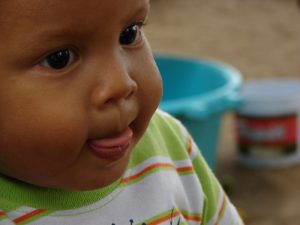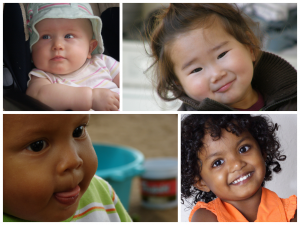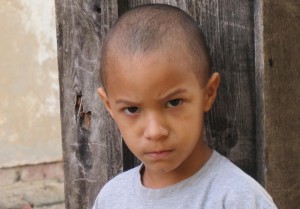Families Today Articles
A resource for parents and professionals, written by T. Berry Brazelton MD and Joshua Sparrow, MD.
Who better to answer some of our most pressing questions about developmental challenges (such as eating, sleeping, weaning, and realationships) than noted pediatrician Dr. T. Berry Brazelton and psychiatrist Dr. Joshua Sparrow? They take thoughtful consideration of both the physical and emotional stages of a child, and how you can respond with sensitivity to the baby’s experience in difficult situations.
We invite you to read, download and share Families Today with others in your community.
FAMILIES TODAY: Babies' Infection Risk on Airplanes
FAMILIES TODAY: “Babies’ Infection Risk on Airplanes”
© T. Berry Brazelton, M.D. and Joshua Sparrow, M.D.
Q: How risky is it to travel by air with a 2- to 4-month-old? Are there reliable statistics on infections?
A: Airplanes confine large numbers of people in a small space. Along for the ride are airborne infections – usually mild ones resulting in coughs, colds and sore throats. Statistics on babies’ on-board risk are hard to gather. An infant may have picked up a common infection before or after flying. Sometimes a rare infection can be traced to a fellow passenger.
Babies aren’t defenseless. Newborns’ blood contains antibodies transferred from their mothers’ blood through the placenta. These antibodies, persisting for roughly the first three months, help babies fight back. So until 3 or 4 months of age, babies may be better protected than during the next few months, when their bodies are developing their own defenses against infection. Breast-fed babies receive another shield: Breast milk contains the mother’s antibodies. Vaccinations also safeguard babies.
Although no parent wants to expose a baby unnecessarily to risk, a healthy baby should be able to fight off a mild infection and recover rapidly. Parents of babies with risk factors will want to take extra precautions. Babies with immune system deficiencies or cystic fibrosis, and babies born prematurely, are likely to be more vulnerable to respiratory infections. Ask your pediatrician for advice.
In certain seasons, airborne, respiratory infections circulate at higher rates than usual. Flu season runs from autumn through winter. For young babies, respiratory synctial virus is a frequent cause of lung and bronchial infections during winter months. If you must travel by air, be sure your baby drinks plenty of fluid during the trip. Pack extra diapers. Breast-feeding mothers need to drink plenty of water too. Be sure to let your baby nurse or suck from a bottle during takeoff and landing. This will help open up the tiny Eustachian tubes from the middle ear to the back of the mouth that equalize the pressure in the middle ear. Often when babies cry during takeoff and landing it is because the pressure in their middle ears is building up. Sucking and swallowing can help. Avoid contact with anyone who is sneezing or coughing. A baby pouch – with the baby facing you, and a thin blanket loosely arranged for adequate air circulation – can help protect airspace from others’ coughs and sneezes.
Before you fly, find out how to reach your pediatrician’s office after hours. It’s also a good idea to tell a pediatrician where you are traveling – just in case a disease alert is in the offing. Your pediatrician may be able to make a referral. And bring a baby first-aid kit, including a thermometer and infant acetaminophen or ibuprofen to use at the pediatrician’s direction.
FAMILIES TODAY: Sleep, Sleep, Dear Sleep
FAMILIES TODAY: Sleep, Sleep, Dear Sleep
© T. Berry Brazelton, M.D. and Joshua Sparrow, M.D.
As a child grows out of babyhood, a family’s goal is for her to feed herself independently and to enjoy eating enough of the right kind of foods to help her grow and be healthy. Parents will of course want to take into account her temperament.
Q: Sleep, sleep, dear sleep. How do I keep my boys (age 3 and 5) asleep at night?
A: The question that parents ask us most often is how to help their young children fall asleep and stay asleep. It may be no coincidence that, on average, adults now sleep two hours less per night than they did 40 years ago. Inadequate sleep interferes with learning, memory and attention. It has been linked to irritability, behavioral problems, and poor academic performance. Poor sleep also may lead to obesity. Hormones that regulate metabolism are secreted in amounts that vary with the sleep-wake cycle. Disrupting the cycle throws off these hormone levels. In our hurried-up, round-the-clock world, a number of factors can keep children from getting all the sleep they need. Street light seeps through shades and shutters, interfering with sleep. Blackout curtains can help. Noise pollution is on the rise: more cars, trucks, buses, ambulances, fire engines, garbage trucks, planes and trains. In cities, the noise goes on all night long. Parents and teachers will need to fight for ordinances that ban late-night honking, truck deliveries and garbage collection. Quiet electric buses and cars would help, too. A “white noise” machine may muffle the sudden unpredictable sounds that come through the walls just as a child is about to fall asleep.
Parents can start by controlling the home environment. If your children are very sensitive to sights and sounds, cover the light-up digital clocks and other electronic equipment in their room. Shut the door of any room with humming machinery – like the dishwasher or the washing machine. Supper time can be a nightly family reunion, a clean break from the day. After supper, reducing the stimulation of TVs, computers and video games can help children and parents unwind. Children can start relaxing for bed: no more running around, phone calls and bright lights. Quiet activities – a bath, a few stories, a lullaby – slow the rhythm and help your children settle down. Soon they will associate this reliable routine with relaxation and rest. Bedtime isn’t for dawdling. Don’t give in to requests for “one more story” or “one more glass of water.” Instead, tell your children that if they are ready for bed – teeth brushed, faces washed, under the covers at the expected time – they can choose three short bedtime stories. Remind them that if they don’t stay on schedule, they will lose a story, one at a time.
Without knowing your children’s sleep habits, it’s hard to know why they are waking up. If they share a bedroom and one child is waking the other, you may need to separate them for sleep if you can. Children this age are capable of sleeping through the night on their own. If the problem persists, we suggest you check with your pediatrician about medical problems that can interfere with sleep, such as asthma, allergies and sleep apnea.
FAMILIES TODAY: A Simple Test of A Baby's Development
FAMILIES TODAY: A Simple Test of A Baby’s Development
© T. Berry Brazelton, M.D. and Joshua Sparrow, M.D.
Q: I am an infant-toddler teacher and first-time mother. I’m reading your book, “Touchpoints: Birth to Three,” and I want to learn more about the assessment you use to evaluate a 9-month-old’s belief in his or her own success or failure.
A: Careful observation is the key. I like to watch a 9-month-old take on a challenge. There is so much to learn from seeing how a child tries something new. I have a simple test that teaches about temperament, and I think it can also be a window into a child’s self-esteem. I give a 9-month-old a wooden block, small enough to fit in his hand but too big to swallow. If he expects to succeed, this sequence often follows: He reaches out to grab the block. He looks at it. Then he looks at me as if to say, “What do you want me to do?” At this age, babies already know that information is written all over our faces, and they know how to read it. If I smile encouragingly, he looks back at the block, turning it around in his fingers.
Meanwhile I bang another block on the table. Ready to imitate, he bangs his block on the table, too. If I bang once, he bangs once. If I bang twice, he bangs twice. If I tap his block with mine, he does the same thing – and then he looks up at me and smiles. Already, we are friends. Then he brings his block to his mouth and rubs it around – his way of getting to know it better. A baby who expects to fail may not even reach for the block I offer to him. If he does, he’s likely to take it from me limply and then may let it drop. He may not bother to look back at me to see what I think. If he does, and if I smile my encouragement, he may not display the same curiosity or seem to care about pleasing me. When I bang my block on the table, it gets his attention. But he watches passively instead of trying it for himself. Already he seems afraid of getting it wrong. Yet children can’t learn if they don’t dare make mistakes.
Next, I hold out a second wooden block. The 9-month-old who expects to succeed clutches the first one tightly, and extends his other hand for the new block. Then he studies it with the same curiosity he showed for the first one. While doing so, he may even forget about the first one and drop it. But when I take my two blocks and slowly show him how I bang them together, he picks up his first block again and tries his hardest to imitate me. When he succeeds, he looks up at me as if to say, “I did it. I did it all by myself. Aren’t I great?”
The 9-month-old who expects to fail may not reach for the second block, having given up on himself with the first. I make it more enticing by turning it around In my fingers so he can look at it, or by banging it gently on the table. Then I put it down next to him – he’s likely to ignore it or just handle it briefly. When I show him how to bang two blocks together, the response is a half-hearted try. He picks up a block with each hand, or I may need to hand them to him again. He may make a brief swipe to try to bring them together. But he misses and looks at me briefly, then at the ground. He won’t try again. Hitting two blocks together is an item from the Denver Developmental Assessment. But when I’m watching to see if a child expects to succeed or fail, I’m not interested in whether he succeeds – but in how he approaches the task, and how he responds to his own success or failure.
FAMILIES TODAY: Feeding A Quiet Child & An Active One
![IMG_6837[1] copy](http://mi-aimh.org/wp-content/uploads/2015/05/IMG_68371-copy-1-300x200.jpg)
FAMILIES TODAY: Feeding a Quiet Child — and One Who is Active
© T. Berry Brazelton, M.D. and Joshua Sparrow, M.D.
(This article is adapted from “Feeding: The Brazelton Way,” by T. Berry Brazelton, M.D., and Joshua D. Sparrow, M.D., published by Da Capo Press, a member of The Perseus Books Group.)
As a child grows out of babyhood, a family’s goal is for her to feed herself independently and to enjoy eating enough of the right kind of foods to help her grow and be healthy. Parents will of course want to take into account her temperament.
Feeding a Quiet Child
A quiet, sensitive child may be on a different track from her peers. She may comply with being fed and continue to be compliant even during the usual times of conflict. For example, unlike other children her age, she may allow herself to be fed into the second year, apparently content to be a passive recipient. Then, all of a sudden, refusal! No longer will she put up with being fed. Passive resistance may be her response. Her refusal to be fed is a warning to her parents to pull back and let her try feeding herself. Since she has not had experience with finger feeding or with utensils, her first attempts to feed herself may be clumsy. A big mess at every meal – food on her face, her clothes, the table, the floor, everywhere – will be the inescapable price for her earlier compliance. Parents may even be thankful for the slobbery mess when it comes – a welcome relief from the initial food refusal of this phase of self-assertion!
Patience with such a child will be the saving grace. Let her learn how to take over the job of feeding. Offer her only two bits at a time of an attractive finger food for each meal. Then ignore her struggle and leave it to her. Keep her company, but don’t cajole during meals. If and when she downs the two bits, offer her two more at a time, until she starts smooshing them or launching them over the edge of her high chair. This means it’s time to stop – until the next meal. Don’t let her “graze” between meals. And for now, don’t worry about a well-rounded diet. Remember that this previously compliant child is quickly learning the skills of self-feeding. It might have taken her several months longer to learn had she been less passive and started in with her attempts to take over her own feeding earlier. Be patient and follow her lead.
Feeding an Active Child
At the other end of the temperament spectrum is the active, constantly moving, curious-about-everything child. She is far more interested in sights, sounds, and rushing around than in food. A parent whose motive is to see that the child is well fed is bound to feel frustrated, even desperate. “Sit down in your seat,” a worried parent will beg as the child climbs out of her high chair to hang teetering on the edge. The child looks up coyly, holding out one hand for a “cookie.” Anything she can eat will do as long as at the same time she can clamber around the house, up and over furniture and into drawers to pull out clean clothes with grubby fingers.
Many parents of active children have asked me: “Should I feed her on the run? She’ll never eat enough sitting down. She barely sits before she’s gone. I wait until she’s hungry, but she never is. I feel like I need to give her bits of food all through the day so that she’ll get enough. What should I do?”
Mealtime Advice
- Keep mealtimes a sacred time for the family to be together. Don’t let the phone or other interruptions interfere.
- When your child loses interest in sitting at the table – that’s it. Put her down and let her know her meal is over. No grazing between meals. No more food until the next meal.
- Make meals a fun time to be together – at least as much as is possible with a squirming, food-throwing toddler. Make meals as companionable as possible – you eat when she does. But if she doesn’t, eat your own meal and let her know that you can chat and be together if she stays at the table. If she squirms to leave, put her down. But she’ll have to wait for your attention until you’re done. Eventually she’ll learn to model on you.
- No television at the table or promises of special sweet desserts to get her to sit and eat.
- Be sure you let her feed herself. Never say, “Just one more bite.” If you do, you’ll be setting yourself up for testing.
- Don’t go to special trouble to cook her a special or exciting meal – your disappointment is likely to outweigh the benefits. Instead, let your child know that “this is what we’re having for dinner tonight.” If she doesn’t want it, she’ll have to see if she likes the next meal any better.
- Let her help with meals as soon as she is old enough to do even the smallest task, such as setting the table (start with the napkins only!), cleaning it with a sponge, and so on.
- Have your child’s pediatrician check her weight and growth, and ask her for supplements if necessary.
- Above all, don’t set meals up as a struggle or her high chair as a prison to keep her in.
________________________
Distributed originally by The New York Times Syndicate with permission to circulate, copy and redistribute through MI-AIMH.
Responses to questions are not intended to constitute or to take the place of medical or psychiatric evaluation, diagnosis or treatment. If you have a question about your child’s health or well-being, consult your child’s health-care provider.
Dr. Brazelton heads the Brazelton Touchpoints Project, which promotes and supports community initiatives that are collaborative, strength-based, prevention-focused sources of support for families raising children in our increasingly stressful world. Dr. Sparrow, a child psychiatrist, is Director of Strategy, Planning and Program Development at the Brazelton Touchpoints Center. Learn more about the Center at www.brazeltontouchpoints.org.
FAMILIES TODAY: Community-Building Among Families
FAMILIES TODAY: Community-Building Among Families
© T. Berry Brazelton, M.D. and Joshua Sparrow, M.D.
Q: I’ve seen parents benefit from the exchange of advice on the sidelines at a soccer game, and by volunteering together for a parent-teach association. But not every parent can participate. How can we help restore and strengthen social networks that nourish parents? Networking reduces not only parents’ anxieties but also overuse of the medical system. Being a parent can be a lonely job. More than half of all children in the U.S. spend part of their time being raised by a single parent.
A: Single or not, working parents are often so busy juggling jobs and family that it’s hard for them to connect with relatives, friends and other parents. Yet when parents compare notes, they are often relieved to discover that they are not alone, that they share mutual concerns about bedtime battles, homework overload, fears about how their children will fare in a world of vanishing resources, to name a few. They realize they aren’t the only ones who sometimes feel like they don’t know how to help their child – that they’ve tried everything and nothing seems to work.Exchanges with other parents provide more solutions and resources, along with confidence and hope. When parents speak their fears out loud and know that they have been understood by others who care, they are likelier to find a fresh perspective.
Parents often feel that they must be perfect, that they should instinctively know what to do with their children. Of course that’s not realistic. Parenting is a process of trial and error where mistakes themselves can be teachers. But parents will only learn from their mistakes if they can face them, and that takes an underlying sense of security. It helps to have a safety net of reassuring relationships with other parents who share their challenges and cheer them on. The sidelines of their children’s soccer games are a fine setting for that back and forth. Perhaps every generation has to learn that it takes a village to raise a child. When communities strengthen themselves, children get supported not only by their own parents but also by all the other parents and adults in their universe.
Pediatricians, teachers and other professionals can help develop opportunities for parents to connect – formal ones such as parent-teacher associations and parent groups, and informal ones, too. I used to schedule pediatric appointments during the same block of time for children of the same age so that their parents could compare notes in the waiting room. Public libraries and children’s museums also have become interested in helping parents get to know each other. But the job of strengthening communities cannot be accomplished by child-oriented professionals and institutions alone. Internet social-networking sites can be helpful tools to share community information. Communities become places where children and families thrive when a critical mass of people and institutions share their commitment to everyone’s well-being.
________________________
Distributed originally by The New York Times Syndicate with permission to circulate, copy and redistribute through MI-AIMH.
Responses to questions are not intended to constitute or to take the place of medical or psychiatric evaluation, diagnosis or treatment. If you have a question about your child’s health or well-being, consult your child’s health-care provider.
Dr. Brazelton heads the Brazelton Touchpoints Project, which promotes and supports community initiatives that are collaborative, strength-based, prevention-focused sources of support for families raising children in our increasingly stressful world. Dr. Sparrow, a child psychiatrist, is Director of Strategy, Planning and Program Development at the Brazelton Touchpoints Center. Learn more about the Center at www.brazeltontouchpoints.org.
Copyright © 2014 Michigan Association for Infant Mental Health, All rights reserved.
FAMILIES TODAY: Preschoolers' Habits: Handle with Care

FAMILIES TODAY: “Preschoolers’ Habits: Handle with Care”
© T. Berry Brazelton, M.D. and Joshua Sparrow, M.D.
(This article is adapted from “Touchpoints: Three to Six,” by T. Berry Brazelton, M.D., and Joshua D. Sparrow, M.D., published by Da Capo Press, a member of The Preseus Books Group.)
Many preschool children go through a period of various self-comforting habits such as hair-pulling, rocking, or biting their nails and skin around them. As if they were exploring the behavior that bothers their parents, they seem to run the gamut of habits. Habit patterns have deep roots. My first child sucked her middle two fingers as a newborn to comfort herself, an unusual pattern – and I found myself taking them out of her mouth. My wife said, “You’d never recommend trying to stop this to your patients. Why do you try to interfere with her sucking?” I couldn’t answer her.
A week later, my mother came up from Texas to see her new grandchild. “Isn’t that amazing? She sucks the same two fingers you used to suck! In those days, finger sucking was considered a bad habit. We tried to stop you, but we never could. You were determined.” I realized then why I’d tried so hard to stop my daughter. Attention to habit pattern is more likely to set it as a problem than to eradicate it. Thumb bandages, terrible-tasting ointments, or other ingenious measures have the opposite effect from that intended.
An older child can be helped to see that she resorts to self-comforting habits when she’s stressed and needs to calm down. Those are signs of tension. Parents can evaluate the pressures on a child who is resorting often to such habits. The pressure isn’t always from the outside. An over-charged, hard-driving child may need such a habit pattern to help her manage her temperamental intensity.
One child, on being reprimanded for her nail-biting, pleaded, “Mummy, can you take my head off? My mouth just bites my fingers. I don’t like it and I don’t know what to do.” This shows the depth of feeling in a child who is trying to control such a symptom. Do we want to add our own pressure to it? Why not say, “Most people bit their nails. Sooner or later you will stop. In the meanwhile, worrying about it won’t help. I’ve made you feel guilty about it, and I’m sorry.” Better to reassure her that the habit is likely to go away. This is more likely to happen if everyone (including the child) can ignore it. The various habits common at these ages – thumb sucking, pulling out hair, nail-biting, stuttering, and the many others that parents encounter – can show a common pattern. (See below for guidelines to identify habits.)
Criticizing the child for a habit makes her feel inadequate, unable to “break” the habit. For these reasons, a parent would best be advised to ignore the behavior from the first. Because all parents are loaded with their own past experiences, this is not easy. Nail-biting was a habit to be “broken” for the last generation. A parent today who was broken of this habit during his own childhood will find it extra hard to “ignore” such behavior today.
HABITS TO GROW OUT OF:
Many 3- and 4-year old children run the gamut of habits. They last only a few weeks or months. Many of these habits may be imitative of a parent, a sibling, or a peer. Habits may serve a self-calming purpose at a peak of frustration or excitement. A child turns to his behavior as she might have to her thumb earlier. A special doll or other treasured object to hold and touch might help to redirect the child’s need for self-comfort.
When a parent sets up a prohibition, this surrounds a habit with heightened interest or excitement and tends to reinforce it. Either the added attention or the use of it as a kind of rebellion makes it satisfying. All this is unconscious on the part of the child. In this way, what might have been transient behavior becomes more fixed – a habit.
Much less commonly, more unusual kinds of involuntary behavior (for example, repetitive hand washing or staring spells, among others) may seem to take on a life of their own and seriously interfere with a child’s daily life. If they have a more bizarre quality, are more repetitive or disruptive throughout the range of a child’s activities, they require professional attention. A health professional is needed to determine whether these are habits or something more serious (such as obsessive compulsive disorder, Tourette’s syndrome, or certain seizure disorders) for which treatment is needed. Your pediatrician can refer you to a pediatric neurologist or child psychiatrist.
________________________
Distributed originally by The New York Times Syndicate with permission to circulate and redistribute through MI-AIMH.
Responses to questions are not intended to constitute or to take the place of medical or psychiatric evaluation, diagnosis or treatment. If you have a question about your child’s health or well-being, consult your child’s health-care provider.
Dr. Brazelton heads the Brazelton Touchpoints Project, which promotes and supports community initiatives that are collaborative, strength-based, prevention-focused sources of support for families raising children in our increasingly stressful world. Dr. Sparrow, a child psychiatrist, is Director of Strategy, Planning and Program Development at the Brazelton Touchpoints Center. Learn more about the Center at www.brazeltontouchpoints.org.
FAMILIES TODAY: Coping with Loss

FAMILIES TODAY: Coping with Loss
© T. Berry Brazelton, MD and Joshua Sparrow, MD
Q: Since her great-grandfather died a few weeks ago, my 4-year-old daughter asks constantly about death. She asks why and how my mother died (which happened before my daughter was born). She wants to know if we parents will die at the same time, and who will look after her. It’s hard to be honest without scaring her. We aren’t religious, so a lot of my answers are, “I don’t know.” What is best to say? Or not to say? My mother died from smoking. Is it too early for that information?
A: Clear, simple information is the key to helping your daughter cope with frightening things that are hard for any of us to understand. You needn’t explain more than what’s required for her age – just tell her enough so she can trust you to guide her through these challenges. Sometimes language that is meant to be reassuring confuses and worries children. “He died in his sleep,” for example, makes many children scared to go to bed. A little reliable information makes the world seems less frightening to a child.
Maria Trozzi, author of “Talking with Children about Loss,” suggests saying, “Most people do not die until they are very, very, very old.” If your daughter asks why, you might reply, “After living for a very, very, very long time, great-grandpa’s body wore out. When people grow very, very, very old, their bodies just stop working.” You can add, convincingly, that you and you parents are not very, very, very old, and that your bodies are working fine. It’s not critical for your daughter to know now about your mother’s smoking. Since people are likelier to die younger if they smoke, your child might wonder why anybody would ever do such a thing. It’s not dishonest to save this explanation for later. Most important is that your daughter knows you are always ready to listen and that you will do your best to answer her questions.
________________________
Distributed originally by The New York Times Syndicate with permission to circulate and redistribute through MI-AIMH.
Responses to questions are not intended to constitute or to take the place of medical or psychiatric evaluation, diagnosis or treatment. If you have a question about your child’s health or well-being, consult your child’s health-care provider.
Dr. Brazelton is founder of the Brazelton Touchpoints Foundation, which promotes and supports community initiatives that are collaborative, strength-based, prevention-focused sources of support for families raising children in our increasingly stressful world. Dr. Sparrow, a child psychiatrist, is Director of Strategy, Planning and Program Development at the Brazelton Touchpoints Center. Learn more about the Center at www.brazeltontouchpoints.org.
FAMILIES TODAY: A 14-month old, Early to Bed and Early to Rise

FAMILIES TODAY: A 14-month old, Early to Bed and Early to Rise
© T. Berry Brazelton, M.D. and Joshua Sparrow, M.D.
Q: My 14-month-old is an excellent sleeper – she has slept through the night since she was 2 months old. However, she goes to bed early and wakes up early (typically 7:15 p.m. to 5 a.m.). I have tried shifting bedtime a little later but it hasn’t affected wake-up time; instead she is cranky and tired until her morning nap, which shifts earlier.
I don’t want to mess with a full night’s sleep, even if it’s not on my preferred schedule. But I find it hard to make evening plans with the rest of the family. Do you have suggestions for (a) shifting to a later bedtime and/or (b) explaining to relatives and friends why it’s so important either to turn down invitations or to leave early to keep her sleep schedule?
A: At 14 months, 10 hours of nighttime sleep is about average. A child this age would also need another hour or two of sleep during the day. (Of course, many children are not average, so sleep requirements vary.) An early-to-bed early riser’s sleep schedule is healthy so long as the child gets the sleep she needs. If you want to try to change her sleep schedule, you will need to shift every sleep-related event – naps, bedtime and mealtimes – in each 24-hour cycle. And you must maintain the pattern consistently, advancing by 10 to 15 minutes each day. The process is like adjusting to a new time zone.
At first, your child probably won’t wake up later and may be tired and cranky. But if you continue this schedule for a few weeks, chances are she eventually will start waking up later in the morning. At that point you would not advance her bedtimes, naptimes and mealtimes any further. She should still obtain the same amount of sleep at night and during naps. If not, you may need to go back by 15 minutes or so, settling on a new schedule that works best for him.
None of this is necessary unless her current schedule bothers the family enough to make the effort. You may indeed prefer not to “mess” with a good night’s sleep. You don’t tell us whether your child appears well rested and wide-awake when she is up: important signs of a healthy sleep pattern. As for the pressure to make your baby conform to others’ schedules, you are her parent. Decisions like these are up to you. You may deflect criticism by making it clear that this is a matter of the child’s biology, not a lack of parental backbone. Assert your authority: “She’s an early bird. Some people just are, and we intend to respect that.” Others’ opinions will bother you less once you feel confident about your stance on your child’s sleep.
________________________
Distributed originally by The New York Times Syndicate with permission to circulate and redistribute through MI-AIMH.
Responses to questions are not intended to constitute or to take the place of medical or psychiatric evaluation, diagnosis or treatment. If you have a question about your child’s health or well-being, consult your child’s health-care provider.
Dr. Brazelton is founder of the Brazelton Touchpoints Foundation, which promotes and supports community initiatives that are collaborative, strength-based, prevention-focused sources of support for families raising children in our increasingly stressful world. Dr. Sparrow, a child psychiatrist, is Director of Strategy, Planning and Program Development at the Brazelton Touchpoints Center. Learn more about the Center at www.brazeltontouchpoints.org.
FAMILIES TODAY: Tough Times, Resilient Families

FAMILIES TODAY: Tough Times, Resilient Families
© T. Berry Brazelton, M.D. and Joshua Sparrow, M.D.
These times of economic insecurity challenge parents who already feel strapped to find enough time, any time, for their young children. Parents everywhere may take comfort from knowing that they are hardly alone in this period of foreclosures, layoffs, dislocations and worries about today and tomorrow. Many parents cling desperately to the jobs they have, no matter how much time is now demanded, and bring home even more stress than ever – doing double time to make up for staff cuts and worried about looming layoffs. Children feel the impact. But parents and children may also find that facing adversity together can strengthen the family – and the community, too, when families share what they have. During this holiday season especially, giving and sharing take on a new meaning.
In most U.S. families today, both parents are in the workforce; 63 percent of mothers (of children under 18) work outside the home. Despite massive layoffs, the demands of the workplace on the families aren’t likely to change all that much. We still need to find ways to adjust to them that will put children’s best interests first.
Today, parents are asked to split themselves in two – for the workplace and for nurturing at home. Increasingly, parents also are “on call” at home via work-linked cell phones, computers and all manner of hand-held devices that can compete for a family’s time. Children must adjust to the pressure on their parents and participate in all the efforts to “make it” in a working family.
More time is the universal need of working parents. For most families, there simply is not enough time to just be together. No time for just dreaming and thinking. No time for oneself. No time for one’s spouse. No time for the children. Children feel the stress their parents are under. Some turn away, as if to prevent themselves from causing their parents further stress. They seem to have given up on moments when they might have their parents to themselves. Others lobby hard to keep their parents turned in to them, even if it means behavior that wrecks the little time they have together.
Children benefit, though, when parents can strike a reasonable balance between work and family. Ellen Galinsky, director of Work Family Directions in New York, asked children what they thought about their mother’s working outside of the home. Most children quickly stood up for their mothers: “Even if she hates her job, we need the money and we all know it.” These children felt that their mothers were “the most important person for me. She’s always there when I’m sick or I need her.” Their mother’s working or not was not their issue. They wanted “focus time” with their mothers, time in which they were uppermost in their thoughts. The most satisfied children valued the “hanging out” time they had with their mothers. Rather than so-called quality time spent on planned excursions or planned togetherness, these children preferred just hanging out with their parents.
For the many parents who must spend the bulk of their time at work, there are ways to turn the priority of work into a positive for the children. It became apparent from Galinsky’s study that children want to be a part of the family’s efforts; they want to understand their parent’s jobs, to be included in the family’s efforts to “make it.” If the family is working together, children do not feel shortchanged. “School is kids’ workplace. My mom and dad have theirs. But we have each other to help us.”
In planning solutions for families in which both parents must work, each parent needs to share in decisions about family priorities. If their children are old enough, they may be included in the decision-making, too. Then, when the questions arise, “Did you see Joey’s flashy new car? Are we ever going to get rid of our old junk heap?” or “She gets an allowance to buy her own toys. Why can’t I have one? You don’t ever buy me anything,” the parent can point to the family’s decisions, trade-offs and the values behind them.
The current economic downturn is a time to re-examine values, and to model more altruistic and less materialistic ones for children. Many parents will now need to be ready to make extra efforts just to try to hold onto their jobs – and their children will again need to adapt. A shift of values toward pulling together, looking out for each other, making sacrifices for each other, and having fun just being together rather than buying together may help many families make the transition to having less. Still, this can’t make up for basic necessities such as food and shelter that more and more families can no longer take for granted. Some may find that they can stretch some of what they have a little farther by sharing their resources with neighbors – carpooling to school or for grocery shopping, or sharing childcare arrangements.
At the same time, they’ll be modeling the kind of values that have made this country strong and always pulled us through tough times. This is a time to pull together, to help each other out, and it will last well beyond this holiday season.
________________________
Distributed originally by The New York Times Syndicate with permission to circulate and redistribute through MI-AIMH.
Responses to questions are not intended to constitute or to take the place of medical or psychiatric evaluation, diagnosis or treatment. If you have a question about your child’s health or well-being, consult your child’s health-care provider.
Dr. Brazelton is founder of the Brazelton Touchpoints Foundation, which promotes and supports community initiatives that are collaborative, strength-based, prevention-focused sources of support for families raising children in our increasingly stressful world. Dr. Sparrow, a child psychiatrist, is Director of Strategy, Planning and Program Development at the Brazelton Touchpoints Center. Learn more about the Center at www.brazeltontouchpoints.org.
FAMILIES TODAY: A Child's Big Emotions
FAMILIES TODAY: A Child’s “Big Emotions”
© T. Berry Brazelton, M.D. and Joshua Sparrow, M.D.
Q: How do I help an almost-6-year-old learn to handle disappointment and frustration? This is a child with big emotions, both positive and negative. Nearly every time he doesn’t get his way, he instantly gives in to his impulse to stomp, throw something, cry, scream, and sometimes hit and push. He is always apologetic and remorseful, and even berates himself, which I find disturbing (he says he is “stupid,” a word we don’t allow in our home).
A: At nearly 6, your son can learn to manage his strong feelings. The work may be hard now, but it will be much harder later. It is good that his behavior bothers him, which may motivate him to change. But if he is feeling hopeless, he will need your reassurance that he will someday learn to control himself. He will need to know that physical aggression is unacceptable, and that you will do everything you can to keep him under control until he can manage on his own. He sounds like he is scared of himself, and he needs to know that he can count on you until he can count on himself. Help from you will be far more effective if he can keep reminding himself that he, most of all, is the one who wants to learn.
In calm times, help him make a list of the triggers for his tantrums. Some triggers will be avoidable, others not. You can strategize together about how to handle both. For example, when he can’t have what he wants right away, he could focus on when he can have it and what he can do while he is waiting. Instead of pushing someone when he is mad, he can stop and think about what he is feeling, and why. Rather than getting physical, he can say, “I’m mad because I wanted to go first. If you won’t let me go first, then I’m not going to play with you.”
Of course he won’t be able to substitute these reasonable responses for the pushing and hitting right away. Tell him he’ll need to be patient with himself. Look at the list and help him to identify any triggers that have warning signs. You can agree on a special code that you’ll both use, such as, “Looks like it’s time to cool down.” But then he’ll need to know how. Ask him to think about what helps him relax when he’s feeling upset. Share with him what you’ve noticed, and give him some ideas to try. For example, leaving the scene to go to his room, not as a punishment but just to cool down, can make a big difference. Does he have a teddy bear to squeeze really hard? Would it help him to wrap himself in his bed covers? Listen to music? Take a shower? Have a cold drink? Or scribble furiously (on paper) until eventually he feels like making drawings or writing about what bothers him?
If these strategies don’t work, you may need more help. Has your child always had “big emotions,” or is this a recent development? Have there been major changes in his life or in your family’s situation that may have gotten under his skin? Have other family members had problems with “big emotions”? If so, we suggest you consult your pediatrician, who can refer you to a mental health professional skilled in working with young children.
________________________
Distributed originally by The New York Times Syndicate with permission to circulate and redistribute through MI-AIMH.
Responses to questions are not intended to constitute or to take the place of medical or psychiatric evaluation, diagnosis or treatment. If you have a question about your child’s health or well-being, consult your child’s health-care provider.
Dr. Brazelton is founder of the Brazelton Touchpoints Foundation, which promotes and supports community initiatives that are collaborative, strength-based, prevention-focused sources of support for families raising children in our increasingly stressful world. Dr. Sparrow, a child psychiatrist, is Director of Strategy, Planning and Program Development at the Brazelton Touchpoints Center. Learn more about the Center at www.brazeltontouchpoints.org.
FAMILIES TODAY: A Child Who Bangs Her Head

FAMILIES TODAY: A Toddler Who Bangs Her Head
© T. Berry Brazelton, M.D. and Joshua Sparrow, M.D.
Q: My 21-month-old daughter head-butts. She has been doing this since about 13 months. She bangs her head on the wall or ceramic floor and doesn’t cry. When told no, she does it again. Sometimes she bangs her head so hard she bruises her forehead. My pediatrician says this is normal. My mother thinks this is abnormal and she should be checked out.
A: Many children bang their heads in the second year when they begin to have temper tantrums or meltdowns. Some also rock themselves forcefully in their cribs or on the floor. These actions seem to be a child’s way to handle uncomfortable feelings – frustration, disappointment, tension, anger, boredom. But of course such behavior frightens parents. Even though toddlers bang their heads hard, I have never heard of one who hurt himself. As a precaution, though, I recommend putting carpet or other “shock absorbers” on concrete floors, cinder block walls and other unyielding surfaces – without making a big deal of it. I don’t think that telling her no will help. If she could stop herself, she probably would. Struggling with her over the issue might give her another reason to bang her head: It not only helps her soothe herself but also gets your attention. Look for opportunities to engage her before she bangs her head. When she is playing quietly by herself, you can help her learn how to prolong her play so she wards off boredom.
Try to protect this quiet time by avoiding interruptions and cutting down on distractions. When she starts to lose interest or to become bored or frustrated, you can move in briefly to help her with what she’s doing or to introduce a different activity. When she’s ready for a break, cuddle her before she gets to the point of head-banging. Look for sources of tension that you can control and try to minimize them. If you or other family members are under stress, take a break and let off steam. Help your daughter focus on her other ways of calming herself, and teach her new ones. Does she like to cuddle with and talk to a stuffed animal? Look at a storybook? Scribble with crayons? Listen to calming music? Or suck his thumb? At the first warning signs for head-banging, offer an alternative like cuddling or singing with you. If all else fails, you can’t do much more than sit nearby and say soothingly, “I am here and I would like to help but I can’t.”
If a child is otherwise healthy and developing on track, he’s likely to outgrow head-banging. If the behavior persists, there may be a more serious problem. If a parent is concerned that a child’s development is not on pace, it is important to alert the pediatrician as soon as possible. Early intervention can make a big difference for developmental delays and disabilities.
________________________
Distributed originally by The New York Times Syndicate with permission to circulate and redistribute through MI-AIMH.
Responses to questions are not intended to constitute or to take the place of medical or psychiatric evaluation, diagnosis or treatment. If you have a question about your child’s health or well-being, consult your child’s health-care provider.
Dr. Brazelton is founder of the Brazelton Touchpoints Foundation, which promotes and supports community initiatives that are collaborative, strength-based, prevention-focused sources of support for families raising children in our increasingly stressful world. Dr. Sparrow, a child psychiatrist, is Director of Strategy, Planning and Program Development at the Brazelton Touchpoints Center. Learn more about the Center at www.brazeltontouchpoints.org.
FAMILIES TODAY: Parents and Children Learn from Each Other
FAMILIES TODAY: Children and Parents Learn from Each Other
© T. Berry Brazelton, M.D. and Joshua Sparrow, M.D.
Q: My husband and I have different opinions about how parents’ behavior affects a child. I believe that the child learns from your behavior and watches how you react to situations, in turn learning how to handle his emotions. If you are patient even when a child is fussy, that helps him learn to be more patient. If you are frustrated with him and speak to him in a negative tone, that has a negative effect.
A: A child’s behavior is both genetic and learned from modeling on parents. The genetic endowment with which children are born gives them limits within which they can develop. Each child is born with strong individual traits.
Our first child was quiet, shy and hypersensitive. I am very intense and active. I reacted quickly and loudly, often injudiciously. The baby would look at me, cowering, as if I were crazy. I found I couldn’t reach her. She drove me to write my first book, “Infants and Mothers: Differences in Development” (New York: Delacorte Press, 1969). Her behavior determined how I reacted. As I realized that her behavior was genetic and more powerful than anything I could change, I adapted to her and she adapted to me. We’ve managed together.
The second baby was more responsive – more like me. She was playful, laughed easily and talked all the time. She responded to my volatile behavior. Her genetic endowment fitted with mine and we’ve always gotten along. Our last two children have each been different from the others but easier for me and for them. I found I learned the most from adapting to the child who seemed most different from me.
I think our differences also contributed to her growth as a person – from a quiet, hypersensitive child to an avant-garde musician. Our efforts to understand each other have led us to realize that we have much more in common than first seemed apparent. Your husband may not fully appreciate just how important he is to his children. Often fathers end up feeling left out and don’t recognize how they affect their baby from the beginning. If a father has been present during pregnancy, and he speaks just after the baby is born, she is likely to turn her head and look for him. After all, she’s been listening to his voice for the past several months. Or watch how a 2-year-old boy looks up at his father adoringly. He proudly puts on his father’s shoes and tries to swagger just like him.
Our children are always watching us and learning from us. Children are born to learn, and parents are children’s first teachers. Children do not come into the world fully programmed to become adults. Of course genes play a role but couldn’t possibly prepare children to adapt to all the circumstances – including their parents’ personalities – they must learn to live with. Both you and your husband are right. A child learns by modeling on the parent, but parents also learn by adapting to their children. If you are reading your child’s cues, she will read yours, and you will learn from each other.
________________________
Distributed originally by The New York Times Syndicate with permission to circulate and redistribute through MI-AIMH.
Responses to questions are not intended to constitute or to take the place of medical or psychiatric evaluation, diagnosis or treatment. If you have a question about your child’s health or well-being, consult your child’s health-care provider.
Dr. Brazelton is founder of the Brazelton Touchpoints Foundation, which promotes and supports community initiatives that are collaborative, strength-based, prevention-focused sources of support for families raising children in our increasingly stressful world. Dr. Sparrow, a child psychiatrist, is Director of Strategy, Planning and Program Development at the Brazelton Touchpoints Center. Learn more about the Center at www.brazeltontouchpoints.org.
FAMILIES TODAY: A 3-Year-Old & Separation Anxiety

FAMILIES TODAY: A 3-Year-Old & Separation Anxiety
© 2010 T. Berry Brazelton, M.D., and Joshua Sparrow, M.D
Q: I am a professional and a married mom with two wonderful boys, ages 3 and 1. The 3-year-old struggles with severe separation anxiety every time I go to work. He wants me to be the person who does everything for him. He throws a fit if his father or grandmother diapers him or helps him dress. Getting out of the house in the morning is so emotionally exhausting that it’s affecting my job.We have a strong bond and spend one-on-one time together every day, but this aspect of parenting is so hard. Now my other boy is starting to behave the same way.
A: Is your 3-year-old close to the person who takes care of him while you are at work? Your confidence in his caregiver can reassure him that everything will be OK until you return. If you have doubts, your boy will pick up on them. If you give in to his tantrums, you are sending the message – even though unintentionally – that he’s right to want you and no one else. At 3, your boy is old enough to understand that you still exist even when you are not in sight. But a reminder will help. Let him know where you are going. Describe your workplace so he can picture you there. Give him a photo of you, or an old small scarf of yours, and tell him to hug it tight or keep it in his pocket. Does he have a favorite stuffed animal or doll? If not, let him pick one – just one – and encourage him to hold it close when he is feeling sad or frightened. Remind him that you have always come back and that you always will. Show him examples of other things that go away and come back, like the sun and the moon and the stars, the day and the night. Read him a book about young children who are either looking for their mothers (“Are You My Mother?” by P.D. Eastman) or running away from them (“The Runaway Bunny,” by Margaret Wise Brown) – the flip side of the same coin.
________________________
Distributed originally by The New York Times Syndicate with permission to circulate and redistribute through MI-AIMH.
Responses to questions are not intended to constitute or to take the place of medical or psychiatric evaluation, diagnosis or treatment. If you have a question about your child’s health or well-being, consult your child’s health-care provider.
Dr. Brazelton is founder of the Brazelton Touchpoints Foundation, which promotes and supports community initiatives that are collaborative, strength-based, prevention-focused sources of support for families raising children in our increasingly stressful world. Dr. Sparrow, a child psychiatrist, is Director of Strategy, Planning and Program Development at the Brazelton Touchpoints Center. Learn more about the Center at www.brazeltontouchpoints.org.
FAMILIES TODAY: Potty Training Around the Clock

FAMILIES TODAY: Potty Training Around the Clock
© 2009 T. Berry Brazelton, M.D., and Joshua Sparrow, M.D.
Q: Our 2-year-and-9-month-old son was potty-trained for daytime fairy easily at 2 and 1/2. At night he is still in a diaper, and he wakes up very wet. How do we help him to stay dry at night?
A: Your son is following the usual pattern for toilet training. Learning to use the potty during the day at 2 and 1/2 should reassure you. Use the same approach for nighttime: Keep things smooth and easy. Staying dry at night often takes more time. Many children sleep so deeply at this age that they don’t sense when their bladders are full. As sleep cycles change, most children grow out of this problem. It is far too early to worry about enuresis, or persistent bedwetting. Most pediatricians won’t make such a diagnosis until a child is at least 5. For children who have been dry at night for several months and then wet the bed, other causes should be considered – for example, a urinary tract infection.
The wait for nighttime dryness can be frustrating. Changing the sheets is no fun, and success seems so close once a child uses the potty during the day. Yet a parent’s overreaction may lead to resistance. If you can avoid drawing attention to it, have your child limit his liquid intake after supper. Before he goes to bed, he can use the potty not once, but twice – in between, you two could read a story together. Then, let him bring his potty to his bed so he can learn to use it on his own when he wakes up at night. Decorate the potty with glow- in-the-dark stickers to help him find it. Many parents have told me they have succeeded in night training by gently waking their child to use the toilet a few hours after lights out – usually just before the parents go to bed. It’s important to keep things low-key. If your son wakes up wet in the morning, don’t make an issue of it. Just respond with an encouraging tone: “Don’t worry. When you’re ready, you’ll be able to stay dry at night.” And he will.
________________________
Distributed originally by The New York Times Syndicate with permission to circulate and redistribute through MI-AIMH.
Responses to questions are not intended to constitute or to take the place of medical or psychiatric evaluation, diagnosis or treatment. If you have a question about your child’s health or well-being, consult your child’s health-care provider.
Dr. Brazelton is founder of the Brazelton Touchpoints Foundation, which promotes and supports community initiatives that are collaborative, strength-based, prevention-focused sources of support for families raising children in our increasingly stressful world. Dr. Sparrow, a child psychiatrist, is Director of Strategy, Planning and Program Development at the Brazelton Touchpoints Center. Learn more about the Center at www.brazeltontouchpoints.org.
FAMILIES TODAY: A 9-Month-Old and Naptime Resistance

FAMILIES TODAY: A 9-Month-Old and Naptime Resistance
© 2010 T. Berry Brazelton, M.D., and Joshua Sparrow, M.D.
Q: Our healthy 9-month-old son has started to resist going down for his naps. We have tried every method in the book (quiet time, reading, rocking, dark room) but he still cries/wails before each nap. On good days, he takes two one-hour naps; on bad days (more often lately), one or two 45-minute naps. He goes to sleep easily at night without nursing and sleeps through for about 10 hours.
A: Most 9-months-olds require about 12 hours of sleep during each 24-hour period – including nighttime sleep and naps. Sleep needs vary among babies. The range for 9-month-olds is from 11 to 13 hours per day, according to pediatric sleep specialist Richard Ferber, M.D. So on “good days” your son is within the average. Many children resist naps, even when they need them. Up until 6 months, most babies take three naps a day – one in the morning, one midday or early afternoon and one later in the afternoon. At around 6 months, one nap is dropped. At around 12 months, babies often drop one of the two remaining naps.
A little ahead of schedule, your baby may be getting ready to switch from two naps to one. When a baby is on the verge of dropping a nap, a period of back-and-forth may follow for a few weeks. This transition is typical of what we call a touchpoint, when an area of development such as sleep becomes briefly disorganized to reorganize into a more mature pattern. One day, your baby may take one nap and skip the other, or he may have trouble falling asleep before both. He’ll also be cranky and tired when he has had fewer or shorter naps. Falling asleep at night may be harder, also. When one nap replaces two, naptime also shifts – between the old morning and afternoon naps. The remaining nap’s length may be longer, or the baby may sleep a little longer at night. At 12 months, the sleep total is only about 30-45 minutes less than at 9 months, so the single remaining nap may be longer than before.
Can a parent help this transition? Try to be sure that the baby is getting enough sleep over each 24-hour period. Inadequate sleep can interfere with falling asleep and sleeping restfully. Help your baby consolidate his two naps into one by putting him down for his morning nap a little later. Put him to bed later, too, which might lead him to sleep longer – thus easing the shift to consolidate morning and afternoon naps. The transition will happen anyway in a few months, if not sooner. You may be just as glad for him to keep napping twice a day for a while longer, even if he struggles to get himself to sleep and the naps are shorter. If he gets tired and cranky, encourage quiet time for cuddling and reading together so that he can get a little rest and comfort even if he can’t sleep then.
(For more information, see “Solve Your Child’s Sleep Problems,” by Richard Ferber, M.D. published by Simon & Schuster.)
________________________
Distributed originally by The New York Times Syndicate with permission to circulate and redistribute through MI-AIMH.
Responses to questions are not intended to constitute or to take the place of medical or psychiatric evaluation, diagnosis or treatment. If you have a question about your child’s health or well-being, consult your child’s health-care provider.
Dr. Brazelton is founder of the Brazelton Touchpoints Foundation, which promotes and supports community initiatives that are collaborative, strength-based, prevention-focused sources of support for families raising children in our increasingly stressful world. Dr. Sparrow, a child psychiatrist, is Director of Strategy, Planning and Program Development at the Brazelton Touchpoints Center. Learn more about the Center at www.brazeltontouchpoints.org.
FAMILIES TODAY: Extremely Bossy Three-Year Old

FAMILIES TODAY: Extremely Bossy 3-Year-Old
© 2010 T. Berry Brazelton, M.D. and Joshua Sparrow, M.D.
Q: I have an almost 4-year-old daughter who is extremely bossy – to me, to our family, to other children. Any advice?
A: A young child’s behavior is her way of letting the world know how she feels before she has developed the ability to put her feelings into words. To understand what her bossiness is “saying,” watch and listen carefully. If she wants everyone to go along with her ideas about what and how to play, she may need guidance about cooperation. If she expects everyone to cater to her whims, you can set limits to teach her that she can’t always have her way. If she seems bossier at specific times, there may be triggers to such behavior – like hunger, fatigue or overstimulation. Watch for these cues and help her to avoid them.
If her bossiness seems a bid for attention, schedule regular times to play together so you won’t find yourself pulled in to play whenever she demands it. When she gets bossy, tell her it’s no fun for you when she acts that way. Then remind her of the great time you had during your last play date. Let her know you’re looking forward to the next one. A child may be bossy before she has learned how her behavior affects other people. Let her know that no one likes being pushed around.
How do you and others respond when she can’t do as she pleases? Giving in won’t help, though it may be tempting if she throws tantrums. Instead, help her learn to control herself. Ask how you can help – with a hug or some quiet time to herself. Some children who feel that their world is out of control may try to control other people. In this case, ease the pressures on her. Look for times and places when she can have her way – such as choosing her cereal or the color of the clothes she wants to wear.
At 4, the social skill to monitor and change behavior in response to others is a work in progress. Four-year-olds are learning to share, to take turns, to invite other children into their play, to follow another child’s lead – the back-and-forth of communication. Is anyone bossing or bullying her? Often children who are rough on others have been victims of such treatment themselves. If your daughter is in preschool, talk to the teachers about how she gets along with her peers. They can help her learn how to compromise and get along. In the classroom she will have plenty of opportunities to practice.
________________________
Distributed originally by The New York Times Syndicate with permission to circulate and redistribute through MI-AIMH.
Responses to questions are not intended to constitute or to take the place of medical or psychiatric evaluation, diagnosis or treatment. If you have a question about your child’s health or well-being, consult your child’s health-care provider.
Dr. Brazelton is founder of the Brazelton Touchpoints Foundation, which promotes and supports community initiatives that are collaborative, strength-based, prevention-focused sources of support for families raising children in our increasingly stressful world. Dr. Sparrow, a child psychiatrist, is Director of Strategy, Planning and Program Development at the Brazelton Touchpoints Center. Learn more about the Center at www.brazeltontouchpoints.org.
FAMILIES TODAY: A 5-Year-Old’s Sudden Change of Heart

FAMILIES TODAY: A 5-Year-Old’s Sudden Change of Heart
© 2011 T. Berry Brazelton, M.D. and Joshua Sparrow, M.D
Q: My 5-year-old granddaughter has taken ice-skating lessons for a little more than a year. A couple of months ago she started crying before her lesson, saying she didn’t like it and didn’t want to go. She was told to give it another try because she had liked it (and the lessons were paid for). Then she started crying before her dance lessons. But when she gets home, she says what a great time she had. Now she’s starting crying before school and having bad days at school. She was always so excited to go to school and telling us all about her day. What could be going on? Is she just “playing around” to see how far she can go? What can we do to help?
A: Five-year-olds who have complied with activities that their parents choose for them may suddenly realize, “I want to decide what I’m going to do – all by myself!” This wish to be in control can be a healthy sign of growing self-esteem: “I’m going to decide what I do now because I know what I’m doing!” To help her open up, commend her for wanting to have a say. Then, if she can tell you what she doesn’t like about these activities, she may be able to focus on what she likes about them. Her parents could make an agreement with her to remind her that she says she enjoys these activities. If a child complains about one activity, she may need help to figure out why. Is it too hard, frustrating or lonely without friends in that class? Is she too tired or hungry at that time of day? Perhaps something frightening happened there? A traumatic experience in one setting can lead a child to be fearful of others.
If you had told us that she was crying most of the time, and if you hadn’t said that after class she realizes she’s had fun there, we might have wondered if she could be depressed. If the crying is limited to these times, and if she is bright and cheerful at home and with friends during less structured activities, that’s reassuring. It is concerning that she is also having “bad days” at school. You need more information about these bad days, about what is going on in school and her behavior there. Her parents could ask her teacher how she is handling the everyday school challenges. Her teacher may have ideas about how to help her enjoy school more. The teacher might even let her parents observe her in the classroom.
Another possible reason for the crying might be trouble with transitions. Many children this age become so absorbed in one activity that they can’t stop and switch to a different one. Reminders 15, 10 and five minutes before it is time to get ready to go can help. Another possibility is that her busy schedule may overtax her parents. If they’re frazzled, she’s bound to feel that way too. When a child is more insistent on staying home or with a parent than avoiding a specific activity, separation may be her challenge. Such anxiety is common at this age, especially after a loss such as the death of a grandparent, or a move, or when a parent has been ill or preoccupied – by stress at work, financial worries or marital tensions. Five-year-olds may also insist on staying home after a new baby is born, as if to reassure themselves that they will not lose their place in the family.
For some children, dance and skating and other classes can just be too much. Your grandchild is only 5. Perhaps she’s trying to tell you that she needs a different pace, a few more breaks during the day, or more time for learning on her own – through play and with her friends. She may not know how to make friends yet – another reason to be miserable at school and in other group settings. Setting up play dates would then be an important first step.
________________________
Distributed originally by The New York Times Syndicate with permission to circulate and redistribute through MI-AIMH.
Responses to questions are not intended to constitute or to take the place of medical or psychiatric evaluation, diagnosis or treatment. If you have a question about your child’s health or well-being, consult your child’s health-care provider.
Dr. Brazelton is founder of the Brazelton Touchpoints Foundation, which promotes and supports community initiatives that are collaborative, strength-based, prevention-focused sources of support for families raising children in our increasingly stressful world. Dr. Sparrow, a child psychiatrist, is Director of Strategy, Planning and Program Development at the Brazelton Touchpoints Center. Learn more about the Center at www.brazeltontouchpoints.org.
Families Today is published with permission granted to MI-AIMH.






 13101 Allen Road
Southgate, Michigan 48195
tel: 734.785.7705 x7194
fax: 734.287.1680
13101 Allen Road
Southgate, Michigan 48195
tel: 734.785.7705 x7194
fax: 734.287.1680





